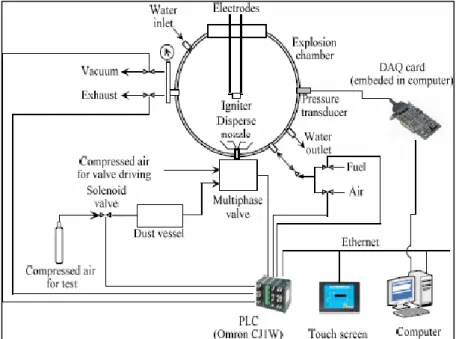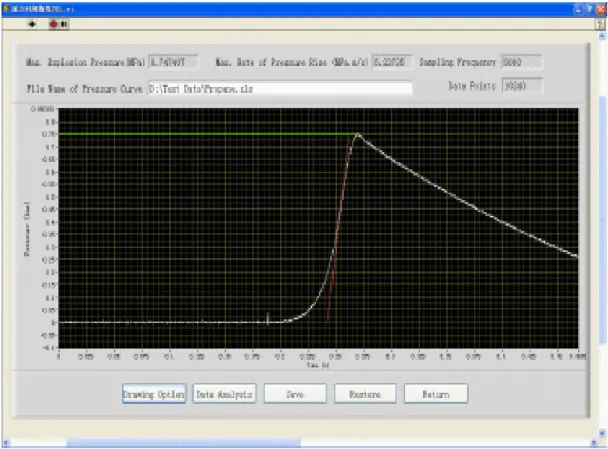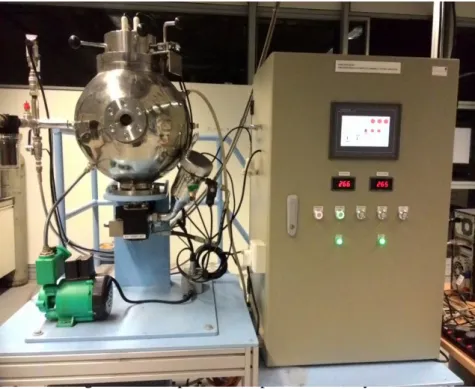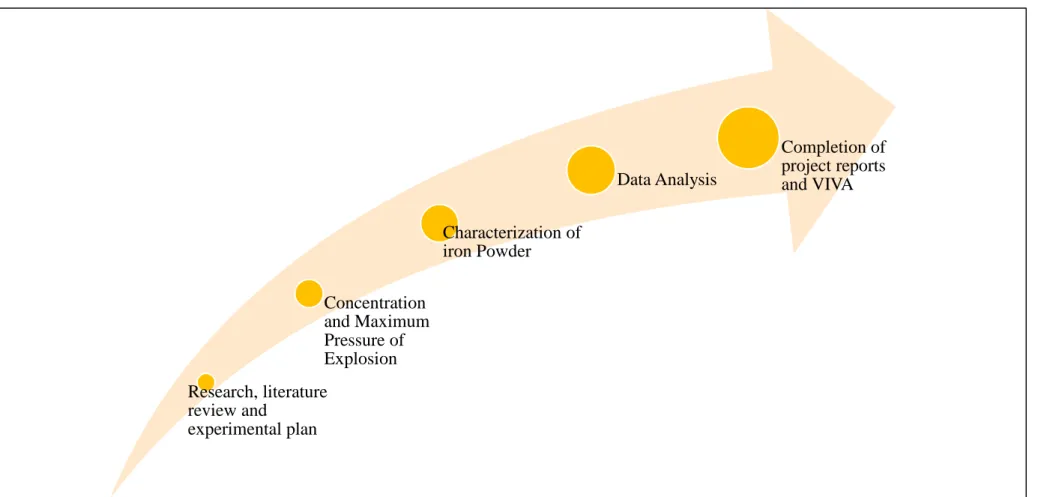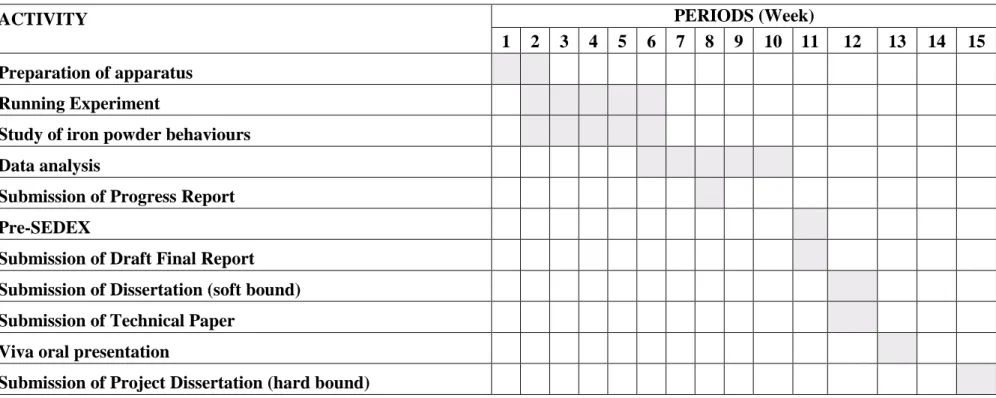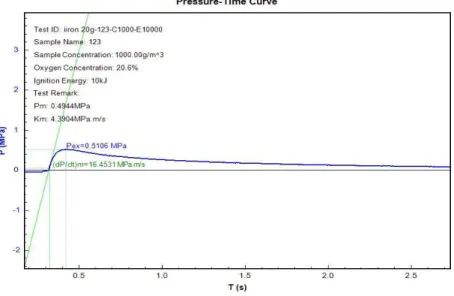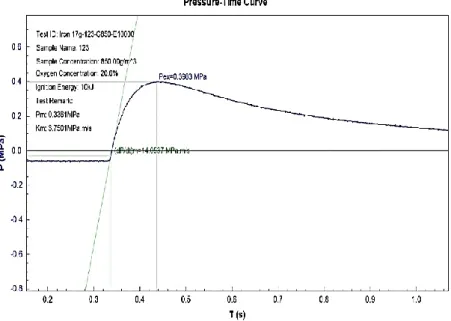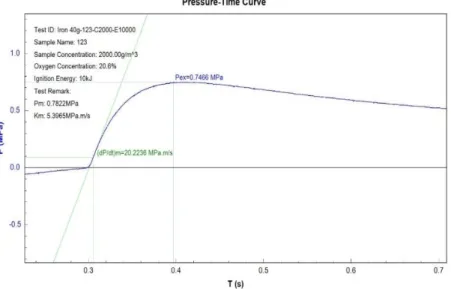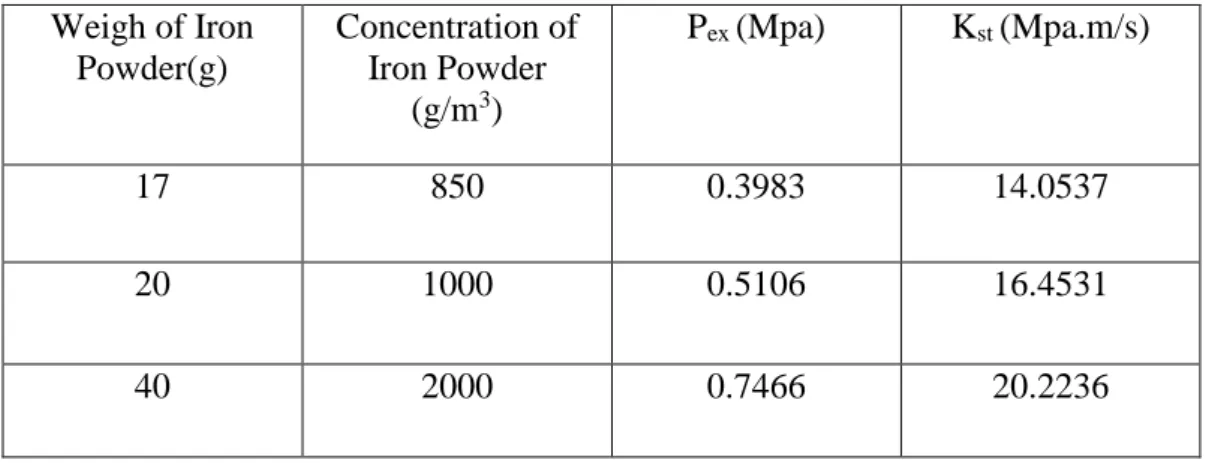Investigating Explosive Behaviours of Metal Powder
by
Aimi Nadia Binti Ab. Kadir 15593
Dissertation submitted in partial fulfilment of the requirements for the
Bachelor of Engineering (Hons) (Chemical Engineering)
SEPTEMBER 2015
Universiti Teknologi PETRONAS, 32610, Bandar Seri Iskandar, Perak Darul Ridzuan.
ii
CERTIFICATION OF APPROVAL
Investigating Explosive Behaviours of Metal Powder
by
Aimi Nadia Binti Ab. Kadir (15593)
A project dissertation submitted to the Chemical Engineering Programme Universiti Teknologi PETRONAS in partial fulfilment of the requirement for the
BACHELOR OF ENGINEERING (Hons) (CHEMICAL ENGINEERING)
Approved by,
__________________
(Dr Azizul Bin Buang)
UNIVERSITI TEKNOLOGI PETRONAS BANDAR SERI ISKANDAR, PERAK
September 2015
CERTIFICATION OF ORIGINALITY
This is to certify that I am responsible for the work submitted in this project, that the original work is my own except as specified in the references and acknowledgments, that the original work contained herein have not been undertaken or done by unspecified sources or persons.
____________________________
AIMI NADIA BINTI AB. KADIR
iv
ABSTRACT
Regarding this project, the micro size of iron powder had been investigated.
Therefore, the problem statement needs to be solved by providing the methods in order to study the behaviour of micro material of metal powder. Explosibility of micron material was determined and compared according to explosion severity and likelihood using standard dust explosion equipment. ASTM methods were followed using a 20L Spherical Explosion Test System. The explosibility parameters investigated for both size ranges of iron include explosion severity (maximum explosion pressure (Pmax) and size-normalized maximum rate of pressure rise (KSt) and explosion likelihood (minimum explosible concentration (MEC), minimum ignition energy (MIE) and minimum ignition temperature (MIT). Iron particle concentration based on different weigh of metal powder. The results show a significant increase in explosion severity as the different concentration show the different severity and explosibility.
ACKNOWLEDGEMENT
Alhamdulillah, I am very grateful to Allah SWT for his Grace and Mercy for giving me strength and opportunity to complete this final year project paper. This study certainly will not realize without constant and never ending supports, guidance and contribution from many people that I have encountered during the course of completing this paper. How I wish so much that I can just list down those people for their encouragement in this historical piece of work but it is surely the impossible things to do.
However, several names deserved special attentions as they have inspired me in so many ways. Firstly my deepest gratitude should goes to my parents, En. Ab Kadir Bin Ismail and Puan Ros’Aini Binti Mohd Yusoff for their endless support and dua’s. Next, my supervisor, Dr. Azizul Bin Buang for his invaluable ideas, encouragement, guidance and constructive comments from beginning until the end of preparing this project paper. Furthermore, I would like to express my gratitude to Lab technicians (UTP) who helped and assisted in conducting and setup the apparatus in Block 4 day and night.
Also, a million thanks to Universiti Teknologi PETRONAS and Chemical Engineering Department for equipping students with essential skills and excellent theoretical as well as practical work throughout the study period.
Last but not least, my deepest gratitude for my family and friends who give me endless love, encouragement and prayers kept me going through this turbulent times. To other that directly or indirectly contributed for this research, thank you for your meaningful kindness.
vi
TABLE OF CONTENTS
CERTIFICATION OF APPROVAL ... ii
CERTIFICATION OF ORIGINALITY ... iii
ABSTRACT ... iv
ACKNOWLEDGEMENT ... v
TABLE OF CONTENTS ... vi
LIST OF FIGURES ... vii
LIST OF TABLE ... vii
CHAPTER 1 INTRODUCTION ... 1
1.1 Background of Study ... 1
1.2 Problem Statement ... 2
1.3 Objectives ... 2
1.4 Scopes of study ... 2
CHAPTER 2 LITERATURE REVIEW ... 3
2.1 Dust Definition ... 4
2.2 Characteristic of the Dust Explosion ... 5
2.3 History of Dust Explosion ... 5
2.4 Maximum Explosive Concentration (MEC) ... 7
2.5 Ignition of Dust Clouds ... 8
2.6 Parameters of Dust Explosion ... 10
CHAPTER 3 METHODOLOGY ... 11
3.1 20L Spherical Explosion Test System ... 11
3.2 System Architecture of Spherical Explosion ... 13
3.3 Electrostatic Spark Ignition ... 16
3.4 Project Key Milestones ... 17
3.5 Ganttchart ... 18
CHAPTER 4 RESULTS AND DISCUSSIONS ... 19
4.1 Maximum Explosion Overpressure (Pex) ... 20
4.2 Explosion Severity ... 21
4.3 Dust Deflagration Index (Kst) ... 21
CHAPTER 5 CONCLUSIONS AND RECOMMENDATIONS ... 23
5.1 Conclusions ... 23
5.2 Recommendations ... 24
REFERENCES ... 25
vii
LIST OF FIGURES
Figure 1 Dust & Fire Explosion Pentagon ... 9
Figure 2 Schematic of 20 Litre Spherical Explosion Test System... 13
Figure 3 Pressure-time curve analysis of gas explosion test ... 14
Figure 4 Explosion Test System ... 15
Figure 5 Project Key Milestones ... 17
Figure 6 Ganttchart ... 18
Figure 7 Concentration of Iron is 850g/m3 ... 19
Figure 8 Concentration of Iron is 1000g/m3 ... 19
LIST OF TABLE
Table 1 Explosion of Severity of micron- size iron powder ... 21CHAPTER 1 INTRODUCTION
1.1 Background of Study
Dust explosions may be classified as being either "primary" or "secondary" in nature. Primary dust explosions may occur inside process equipment or similar enclosures, and are generally controlled by pressure relief through purpose-built ducting to the external atmosphere. Secondary dust explosions are the result of dust accumulation inside a building being disturbed and ignited by the primary explosion, resulting in a much more dangerous uncontrolled explosion inside the workplace.
Historically, fatalities from dust explosions have largely been the result of secondary dust explosions.
Dust explosions have a history that extends back to the 18th century with the first documented dust explosion on December 14, 1785 in Turin, Italy. Count Morozzo reconstructed the series of events leading up to the explosion and provided remarkable insight into the probable cause of the explosion in a 1795 report featured in the “Memoirs of the Academy of Science of Turin”. The explosion occurred at Mr. Giacomelli’s Bakery Warehouse when flour dust generated during normal handling operations allegedly contacted an ignition source in the form of a lamp mounted to help flour handlers see. The resulting explosion propagated in multiple directions injuring two employees working in the warehouse. We learn in Morozzo’s report that the flour was dry; there was less moisture than usual.
According to Morozzo’s interview with the bakery owner, the flour was the driest seen in the bakery that year. Morozzo’s account of the explosion also mentions a dispersed cloud of flour originated when flour from the upper portion of the warehouse drop to lower portion of the confined warehouse. The report
2
captures the rapid, violent nature of the fire and explosion in great detail. Not only had Morozzo given us the early paradigm for the dust explosion pentagon, his report paints a vivid picture of how deflagration fire and pressure propagate through a confined area.
1.2 Problem Statement
Lack of study and research on metal powder (iron powder) that can explode within its specific characteristic.
1.3 Objectives
1) To investigate the explosion severity of iron powder
2) To study the parameters that affected the behaviours of the iron powder.
1.4 Scopes of study
The scope of study involves the parameters and mechanism of the dust explosion itself. Therefore, the further investigation and research would be made in order to find out those characteristics of the metals powder to explode.
CHAPTER 2
LITERATURE REVIEW
The ignition and combustion characteristics of micro sized iron particle metal fuels were investigated by using explosion chamber. Based on thermogravimetric experimental results, the combustion characteristics of the iron particle metal powder were obtained and analysed. Ignition temperatures as well as maximum combustion temperatures and apparent activation energies of the different sized iron particles burning in air were calculated and determined. Results indicate that the ignition temperature of 30 to 110nm sized iron particles is about 280℃. The maximum combustion temperature is 750 to 950℃ and the activation energy is about 20 to 30kJ/mol, the ignition temperature of 2 to 5μm submicron sized iron particle is about 380℃ with maximum combustion temperature 950 to 990℃ and activation energy 37kJ/mol while the values of 40μm micron sized iron particles are 600℃, 1 000℃
and 58 kJ/mol respectively. With particle size decreasing from micron down to micro scale, surface area of the iron particles increases dramatically causes the obviously decreasing of temperature at maximum weight gradient in TG/DTG curves and final maximum combustion temperature. The ignition temperature and activation energy all drop apparently with the size changing of particles. Therefore, activities of the iron particle metal fuels can be greatly enhanced with decreasing of particle size.
Experimental evidence shows that there exists, for carbonaceous and metallic materials, mainly two combustion regime that are either kinetically controlled
4
for small size particles, or diffusion controlled, for large size particles. From the experimentally measured combustion data of those materials, the dependencies of the ignition temperature and the minimal explosive concentration (MEC) with regard to the particle size have been identified.
Overall, it is found that as the particle size decreases, minimum ignition temperature (MIT) and minimum ignition energy (MIE) decrease, indicating higher potential inflammation and explosion risks for the use of micropowders. By contrast, the minimal explosion concentration (MEC) did not show strong variations as the particle size decreases. Rather, a theoretical plateau is observed, which was experimentally confirmed. It can be observed that carbon micropowders exhibit a low propensity to explode while metallic micropowders can be very reactive, thus delineating high potentials for explosion risks in manufacturing facilities.analyzed.
2.1 Dust Definition
When a mass of solid flammable material is heated it burns away slowly owing to the limited surface area exposed to the oxygen of the air. The energy produced is liberated gradually and harmlessly because it is dissipated as quickly as it is released. The result is quite different if the same mass of material is ground to a fine powder and intimately mixed with air in the form of a dust cloud. In these conditions the surface area exposed to the air is very great and if ignition now occurs the whole of the material will burn with great rapidity; the energy, which in the case of the mass was liberated gradually and harmlessly, is now released suddenly with the evolution of large quantities of heat and, as a rule, gaseous reaction products.
Materials in dust form have high mobility due to its size and high dispersion ability.
Dust explosion have been well researched for particles in the micron-range region for different types of metals (Cashdollar & Zlochower, 2007).
2.2 Characteristic of the Dust Explosion
When a mass of solid flammable material is heated it burns away slowly owing to the limited surface area exposed to the oxygen of the air. The energy produced is liberated gradually and harmlessly because it is dissipated as quickly as it is released. The result is quite different if the same mass of material is ground to a fine powder and intimately mixed with air in the form of a dust cloud. In these conditions the surface area exposed to the air is very great and if ignition now occurs the whole of the material will burn with great rapidity; the energy, which in the case of the mass was liberated gradually and harmlessly, is now released suddenly with the evolution of large quantities of heat and, as a rule, gaseous reaction products.
Materials in dust form have high mobility due to its size and high dispersion ability.
2.3 History of Dust Explosion
Even though mention of dust explosions is found in literature since 1785, systematic records are available only from the early 20th century. One of the earliest recorded and the most serious of the accidents triggered by dust explosion occurred at Leiden, the Netherlands, on 12 January 1807. A ship with about 85,000 kg of black powder on board had arrived from Ouderkerk (near Amsterdam) and had moored in the centre of Leiden against all regulations. It is believed that the attempts of the four-member crew to prepare their food on a stove ignited the dust leading to a detonation estimated to be equivalent to 9000 kg of exploding TNT. The explosion killed 151 and wounded about 2000. Houses collapsed up to a distance of 155 m from the ship and within the whole city people were hit by flying debris, glass, and roof tiles. Another catastrophic dust explosion of pre-modern era involved grain dust at the Peavey terminal elevator at Duluth, the USA, in 1916. After the explosion, the cribbed grain bins caught fire, completely destroying the elevator. It was described as one of the ‘worst roaring infernos’ witnessed in a dust explosion.
6
In 1919, a dust explosion occurred in a corn processing plant in Iowa, the USA, and killing 43. Five years later, a dust explosion at a similar plant in Illinois (the USA) left 42 dead. In 1949, at the Port Colbourne elevator in Ontario, Canada, an explosion occurred in the steel bins which blew off the entire roof. The ensuing fire also caused significant damage to the head house. A grain dust explosion ripped through the grain elevator no. 4A of the Saskatchewan grain pools on 24 September 1952, killing 6 and injuring 14. The primary explosion in a shipping bin was followed by a secondary explosion involving large quantities of dust, which had been allowed to accumulate in the building. The roof gallery above the bins was also destroyed.
Dust explosions occur frequently in feed mills. A corn dust explosion in the Wayne Feeds at Waynesboro, the USA, on 25 May 1955, killed 3 and injured 13.
The violence of the explosion caused extensive property damage. Another severe explosion occurred in Kansas City, the USA, in 1958, when the Murray elevator was badly damaged. The head house of steel construction was completely shattered and its installations destroyed by fire.
A dust explosion, which was caused during the welding of a spout, excessively worn by the flow of grain, occurred in the Kampffmeyer grain silo at Albern near Vienna, Austria, 4 July 1960. The welding was being performed in the elevator pit, when a spark ignited the dust in the running bucket elevator. The pressure wave of the explosion went up through the elevator shaft, ripping the casing of the elevator leg, and continuing up to the roof, causing severe damage to the building and machinery.
At the Sun flourmills in London, UK, on 7 August 1965, 4 men died and 37 were injured when a giant blast shattered and set ablaze the mill building and a wheat storage silo of cribbed construction. The explosion is believed to have been triggered by a welding flame being used on a flour bin.
A violent dust explosion on 14 December 1970, shattered the grain silos at Kiel-Nordhafen on the Kaiser Wilhelm ship- ping canal, connecting the North and the Baltic seas. It was the worst accident of its kind in Germany. Six men died and 17 were injured. The damage to plant, building and machinery is estimated at 10 million dollars. At Destrahan near New Orleans, USA, a Bunge Corporation terminal elevator with an 8,000,000 bushel capacity was badly damaged in a massive dust explosion. The entire roof gallery above the storage tanks was blown off. The heat from the explosion and the resultant fire badly damaged the concrete storage bins and the adjacent workhouse.
In 2010, the workers were killed in iron dust explosion accident in West Virginia, and 14 workers were killed in a 2008 sugar dust explosion in Georgia. The U.S. Chemical Safety and Hazard Investigation Board (CSB) identified 281 combustible dust incidents between 1980 and 2005 that led to the deaths of 119 workers, injured 718, and extensively damaged numerous industrial facilities.
A wide variety of materials that can be exposable in dust form exist in many industries. Examples of these materials include: food (e.g., candy, sugar, spice, starch, flour, and feed), grain, tobacco, plastics, wood, paper, pulp, rubber, pesticides, pharmaceuticals, dyes, and coal, metals (e.g., aluminium, chromium, iron, magnesium, and zinc). These materials are used in a wide range of industries and processes, such as agriculture, chemical manufacturing, pharmaceutical production, furniture, textiles, fossil fuel power generation, recycling operations, and metal working and processing which includes additive manufacturing and 3D printing.
2.4 Maximum Explosive Concentration (MEC)
Although an intimate mixture of a flammable dust and air may burn with explosive violence, not all mixtures will do so. There is a range of concentrations of the dust and air within which the mixture can explode, but mixtures above or below
8
this range cannot. The lowest concentration of dust capable of exploding is referred to as the lower explosive limit and the concentration above which an explosion will not take place as the upper explosive limit. (Amyotte & Eckhoff, 2010). The lower explosive limits of many materials have been measured. They vary from 10 grams per cubic metre to about 500 grams per cubic metre. For most practical purposes it may be assumed that 30 grams per cubic metre is the lower explosive limit for most flammable dusts. Though this may seem to be a very low concentration, in appearance a cloud of dust of such a concentration would resemble a very dense fog.
The upper explosive limits are not well defined and have poor repeatability under laboratory test conditions. Since the upper explosive limit is of little practical importance, data for this parameter is rarely available. The most violent explosions are produced when the proportion of oxygen present is not far removed from that which will result in complete combustion. The range of the explosive concentrations of a dust cloud is not simply a function of the chemical composition of the dust; the limits vary with the size and shape of the particles in the dust cloud.
2.5 Ignition of Dust Clouds
Although mixtures of dust and air within the flammable range are capable of explosion, they will not explode unless they are ignited in some way. Once a source of ignition is presented to the flammable mixture, flame will propagate throughout the cloud. The mode of ignition of a dust cloud is typically a hot surface, an electrical spark or a mechanically generated frictional spark. The minimum condition necessaryto initiate a dust explosion with certain modes of ignition can be measured and some results are listed below. Data is provided for comparison purposes only and must not be used for explosion protection design.
Figure 1 Dust & Fire Explosion Pentagon
Combustible dusts include fine particles, fibers, chips, chunks, or flakes that when suspended in air could potentially cause a fire or an explosion. Combustible dust hazards exist in a variety of industries such as food processing, grain handling, plastics, forest products, furniture, textiles, pharmaceuticals, and metal fabrication, among countless others. Raw materials such as wood, flour, sugar, coal, and some metal dusts can present very dangerous conditions in the right situations.
Any combustible material, and even some materials typically considered non- combustible, can burn rapidly when divided into a small enough form. Generally speaking, the smaller the dust particle, the greater the potential hazard. The National Fire Protection Association (NFPA) recognizes that dust particles sized 420 microns or smaller cause the most concern. But for mixtures of varied particle sizes, research has shown that an explosive mixture exists if only two percent of the total dust concentration is sized 420 microns or less. For comparison, table salt and granulated
10
sugar grains are generally between 150 and 850 microns in diameter. If such a dust is suspended in the right concentration within an enclosed area, a violent explosion can result. The force of such an explosion can destroy entire buildings and cause serious injury or death. Depending on the particle size and type, and the area of compartment during dispersal, a dust layer of only 1⁄32 inch deep (0.79 mm, about as thick as a paperclip) is enough to cause an explosion.
2.6 Parameters of Dust Explosion
Dust explosion test apparatus consists of the explosion chamber, dispersion and ignition system, pressure-measuring system and an automated control system.
The explosion chamber is a spherical stainless steel vessel with a capacity of 20L and pressure rating of 20bar (g) surrounded by a water jacket for thermostatic control. At the base of the chamber is a solenoid valve to which a 0.6-L dust storage chamber is connected. Main access into the chamber is through a 94-mm diameter opening at the top. A bayonet closure, that also holds the igniter leads, fits tightly into this opening and seals the chamber. Two30-mm (outer diameter) flanges are fitted on the chamber; the first houses the pressure transducers, while these condition a sight glass for visual observations during tests. Other fittings attached to the explosion chamber are two valves the exhaust valve for venting and the vacuum valve for evacuating the vessel prior to dispersion. The explosibility parameters investigated iron powder include maximum explosion pressure (Pmax), size-normalized maximum rate of pressure rise (KSt), minimum explosible concentration (MEC), minimum ignition energy (MIE), and minimum ignition temperature (MIT).
CHAPTER 3 METHODOLOGY
3.1 20L Spherical Explosion Test System
20L spherical explosion test apparatus is an internationally used laboratory test apparatus for determining explosion characteristics of combustible dusts and gases. It can determine the following explosion characteristics of combustible dust and gas:
Maximum explosion pressure and maximum rate of explosion pressure rise of dust.
Lower explosion limit (LEL) of dust.
Limiting oxygen concentration (LOC) of dust
Maximum explosion pressure and maximum rate of explosion pressure rise of gas.
Lower explosion limit (LEL) and upper explosion limit (UEL) of gas.
With rapid development of automatic measurement technique, virtual instrument (VI) is more and more popularly used in industries and laboratories. VI is an integration of modern electronics, transducers, instrumentation, and computer techniques. The hardware of the VI exploits the capacity of the transducer, signal condition circuit, and computer resources, and so forth. Software is the key component of VI. Given different software, the VI can transform into different instruments. VI is the newest development trend in the field of instrument tasks, which are common in science and engineering laboratories, comprise the application area known as instrumentation. LabVIEW enables rapid development of
12
functionally rich applications appropriate for both bench top applications and larger integrated systems. The language has several key features such as turnkey measurement and control function, Data Socket and VI server, simple user interface LabVIEW is a graphical programming language developed by National Instruments.
It is based on the dataflow paradigm and is designed to facilitate development of data acquisition, analysis, display and control applications. These implementation, multithreaded programming environment that make it particularly useful in an automation environment for creating applications to control and integrate instrumentation, manage process flow, and enable data acquisition. LabVIEW and computer DAQ have been widely utilized to update and modernize industrial equipment and laboratory experimental apparatus.
In this paper, a 20 Litre spherical explosion test apparatus for determining explosion characteristics of combustible dusts and gases was designed, developed, and constructed. Integrated with this apparatus is a LabVIEW-based control and DAQ system. The developed test apparatus not only realizes automatic, remote control, but also realizes automatic data acquisition, data storage, data processing, result display, database management and report etc. It has advantages of easy expandability, friendly interface, easy operation, etc.
3.2 System Architecture of Spherical Explosion
Figure 2 Schematic of 20 Litres Spherical Explosion Test System
The schematic of 20 litre spherical explosion test system is shown in Figure 2. The test system consists of 20L spherical explosion chamber and control and DAQ system. Figure 2 is a photo of explosion chamber. The explosion chamber is a double-layered stainless steel vessel. The principle is to form explosion atmosphere in the vessel and ignite it at a given ignition delay. For dust explosion test, dust sample is put into the dust vessel, and dispersed by compressed air. For gas explosion test, fuel gas and air (or mixture gases with given oxygen concentration) are introduced by valves. The pressure was recorded by pressure transducer and acquired by an A/D conversion card. Explosion characteristics can be obtained by analyzing the explosion pressure curve. The temperature of the explosion vessel before explosion can be controlled by cycling liquid in the water jacket.
14
The control and DAQ system consists of some hardware devices and a software system. The relevant hardware devices include a PCB ICP 113A21 type pressure transducer, an Advantech PCI1711 type DAQ card, an OMRON CJ1M-type PLC, a touch screen and a computer. The experimental process is controlled by PLC, and the upper-level software for control and DAQ was mainly developed using LabVIEW.
Figure 3 Pressure-time curve analysis of gas explosion test
The configuration of the control and DAQ system is shown in Figure 3. Three main functions can be achieved by the test system. The first is pressure DAQ function. The pressure signals are converted into analogue signals by pressure Sensors, and then into digital signals in the DAQ card and then are sent into computer. Finally, the acquired data can be stored, displayed and processed on the LabVIEW platform. The second function is monitoring and control of experimental process. The valves and switches to be controlled are connected to PLC. An Ethernet connection is used for communication between PLC and the top level computer. The experiment apparatus were controlled over a network connection through interaction with an OPC Server. The third one is database management function. A dynamic linked library (DLL) for database access was developed in C#. It can interact with Microsoft Access database by ADO.NET. Then, by invoking this DLL applications through the .NET tool provide with LabVIEW, the database management of experimental results can be realized in the test system.
Figure 4 20L Spherical Explosion Test System Figure 4 Explosion Test System
16 3.3 Electrostatic Spark Ignition
Select “Electrostatic” ignition mode in the human interface before the first test
1) Run “ExTest” software, create new test card in database management interface and fill test information.
2) Weigh dust sample (iron powder) and put the sample into the vessel sample, screw the sample vessel cover tightly.
3) Close the cover of the test vessel. Screw the cover to lock position and set the safety interlock to its home position. Connect the HV cables between the HV terminal of control box and electrode sockets.
4) Turn on the HV power supplies, start change when the voltages become steady. Stop charging when the capacity voltage equals with the power voltage, or when the capacity voltage doesn’t change anymore.
5) Click menu item “File – New test” in software interface, and input test condition information in the “New Test” interface. Then click “Start Test”
button to show the “Acquisition progress” interface waiting for the trigger signal.
6) Click “Gas Supply” button with 20bar of pressure (Intake pressure 2.4Mpa).
7) Close the exhaust valve and gas introduction valves, open the vacuum valve.
Turn on the vacuum pump. First slowly open vacuum gauge valve. If the pointer moves towards vacuum (-0.1Mpa direction), then fully open the valve. When the vacuum indicator reaches -0.065Mpa, close vacuum valve and turn off the vacuum pump. Wait about 3 seconds, then regulate the vacuum to -0.06Mpa using the vacuum valve and exhaust valve. Then close the vacuum gauge valve and all other valves.
8) Press “Prepare gas” button, when the “Pressure Ready” light is on, press
“Igniton” button to start the explosion.
9) Press “Slow Discharge” Button to release the energy left in the capacitances.
If the capacity voltage is lower than 200V, press “Fast Discharge”.
10) “ExTest” software will show the pressure-time curve of the test. The result will be written down into the table and recorded in the database.
11) Clean the vessel.
3.4 Project Key Milestones
Research, literature review and
experimental plan
Concentration and Maximum Pressure of Explosion
Characterization of iron Powder
Data Analysis
Completion of project reports and VIVA
Figure 5 Project Key Milestones
18 3.5 Ganttchart
ACTIVITY
PERIODS (Week)
1 2 3 4 5 6 7 8 9 10 11 12 13 14 15 Preparation of apparatus
Running Experiment
Study of iron powder behaviours Data analysis
Submission of Progress Report Pre-SEDEX
Submission of Draft Final Report Submission of Dissertation (soft bound) Submission of Technical Paper
Viva oral presentation
Submission of Project Dissertation (hard bound)
Figure 6 Ganttchart
CHAPTER 4
RESULTS AND DISCUSSIONS
Figure 7 Concentration of Iron is 850g/m3
Figure 8 Concentration of Iron is 1000g/m3
20
Figure 9 Concentration of Iron is 2000g/m3 4.1 Maximum Explosion Overpressure (Pex)
The meaning of Pmaxis the difference between pressure at the time of ignition at normal pressure and pressure at the highest point in the pressure at the highest point in the pressure time record resulting from a dust explosion. Pex is obtained from the highest corrected value of explosion overpressure over a wide range of fuel concentration. The graph of explosion overpressures versus time in second is represented in the three figures above. The test was performed in by using Spherical Explosion Test Apparatus. Explosion overpressures will increase as the dust concentration increase. The value at the highest point of explosion overpressure is called Pmax while the concentration at that point is the optimum dust concentration.
At minimum value of dust concentration where the pressure is first observed is called minimum explosibility concentration or lean flammable limit.
4.2 Explosion Severity
The explosion severity of the micron-size iron samples can be seen in Table 1. Pmax and KSt both increasing respectively with increasing weigh of iron powder from 17g, 20g and 40g respectively. As the particle weigh is further increase, Pmax
increases and KSt also increase respectively. The micron-size data therefore show the expected increase in Pmax and KSt with increasing concentration of iron powder (referring to Figures)
Table 1 Explosion of Severity of micron- size iron powder Weigh of Iron
Powder(g)
Concentration of Iron Powder
(g/m3)
Pex (Mpa) Kst (Mpa.m/s)
17 850 0.3983 14.0537
20 1000 0.5106 16.4531
40 2000 0.7466 20.2236
4.3 Dust Deflagration Index (Kst)
Kst is an index used to classify the explosion is an index used to classify the explosion severity of a combustible dust.
It is based on the maximum rate of pressure rise, (dP/dt) rise, (dP/dt)max and the units are bar/second.
Kst = (dP/dt) = (dP/dt)max* V1/3
This concept is introduced for scaling the maximum rates of pressure rise to larger volumes by normalizing them. The result of explosion severity may be used to design the basis for explosion protection and mitigation such as explosion relief
22
venting and explosion suppression but it depends entirely on the validity of the cube root law. According to Eckhoff [2003], cube root law is only valid in geometrically similar vessels, if the flame thickness is negligible compared to the vessel radius, and if the burning velocity as a function of pressure and temperature is identical in all volumes. Kumar et al.gave the influence of Kst on dust concentration of cornstarch /air mixtures for quiescent and turbulent by applying the fan for turbulence condition.
It is found that turbulent condition gave rise on Kst value of the dust for increased dust concentration. For example, at 600 g/m3 of cornstarch/air mixtures, Kst of turbulent condition gave about 180 compared to 70 for quiescent condition. This can be said that Kst value is varied depending on the dynamic state of the dust cloud i.e.
turbulent or quiescent and its combustion rate.
CHAPTER 5
CONCLUSIONS AND RECOMMENDATIONS
5.1 Conclusions
Equipment has been manufactured and where necessary existing equipment has been modified and configured to allow the safe handling and testing of metal powders. The equipment comprises:
• 2 litre explosion test apparatus for measuring the rate of pressure rise and the maximum explosion pressure.
• Minimum ignition energy test apparatus. The minimum ignition energy (MIE) of metal powder was measured using a spherical explosion test system.
KSt , Pmax and MIE values have been obtained for different concentration of iron powder. The KSt is an equivalent value scaled from the results obtained in the 2 litre vessel. Generally, the explosibility (maximum explosion pressure, rates of pressure rise and KSt) of metal powders are broadly similar to conventional micro scale powders which we don’t have plenty time and research to do so. Dust explosion may pose severe destruction to human, properties and environment. However, by understanding the fundamental cause and understanding on the severity explosion characteristics of the dust, the hazard and risk of dust explosion can be minimized.
Overpressure and Kst are the crucial parameters which the higher the value of Pmax and Kst, the more violent the hazard and risk of dust. These parameters also depend on other influent factors such as the dynamics state of the dust clouds, oxygen content, dust concentration and particle size. By understanding the possible hazard posed by the value of Pmax and Kst on dust clouds, the appropriate method of protection and mitigation may be applied accordingly and effectively.
24
The inerting method using carbon dioxide and nitrogen has become a promising and economical method in industrial dust explosion protection.
5.2 Recommendations
One of the effective and inexpensive methods of preventing explosive dust clouds is by inerting the air by adding inert gas or other substance such as rock dusting. The explosive dust cloud can be inerted by mixing the air with an inert gas such as nitrogen or carbon dioxide up to a level on which the dust cloud can no longer propagate a self-sustained flame. The use of carbon dioxide as an inert is more efficient than nitrogen for inerting carbonaceous gas whereas nitrogen is more efficient inert for using on metal dusts. However, reducing the oxygen concentration in atmosphere by adding nitrogen, may pose suffocation hazard to human, but research has shown that by adding a few volume of CO2 to the mixture may reduce the suffocation hazard as it will reduce the critical oxygen threshold. Research has also confirmed that by reducing the oxygen content in atmosphere, the ignition sensitivity and combustion of the dust cloud are decreased. The work found that minimum ignition energies of dust clouds increase with moderate reduction of the oxygen content. Rock dusting has been used extensively since early centuries to prevent and inhibit a coal dust explosion in coal mining. The coal dust in mines is thermally inerted by spreading rock dust on the floor, ribs, and roof of mine passageways.
REFERENCES
Abbasi, T., & Abbasi, S. (2007). Dust Explosion-Cases, causes, consequences, and control.
Amyotte, P. R., & Eckhoff, R. K. (2010). Dust explosion causation,. Chemical Health & Safety.
Boilard, S. P., Amyotte, P. R., Khan, F. I., Dastidar, A. G., & Eckhoff, R. K. (2013).
Explosibility of Micron and Micro-Size Titanium Powders. Loss Prevention in the Process Industries, 26(6), 1646-1654.
Cashdollar, K., & Zlochower, I. A. (2007). Explosion temperatures and pressures of metals and other elemental dust clouds. Loss Prevention in the Process Industries , 337-348.
Dufaud, O., Traore, M., Perrin, L., Chazelet, S., & Thomas, D. (2010). Experimental investigation and modelling of aluminium dusts explosion in the 20 L sphere.
Loss Prevention in the Process Industries, 23(2), 226-236.
Eckhoff, R. K. 2005. Current Status and Expected Future Trends in Dust Explosion Research. Journal of Loss Prevention in The Process Industries 18: 225- 237.
Eckhoff, R. K. 2009b. Understanding Dust Explosions. The Role of Powder Science and Technology. Journal of Loss Prevention in The Process Industries 22:
105-116.
Horikoshi, S., & Serpone, N. (n.d.). Introduction to microparticle.
Kalejaiye, O., Amyotte, P. R., Pegg, M. J. and Cashdollar, K. L. 2010. Effectiveness of Dust Dispersion in the 20L Siwek Chamber. Journal of Loss Prevention in The Process Industry 23: 46-59. Mittal, M. (2014). Explosion characterisitc of micron- and micro-size magnesium powders. Loss Prevention in the Process Industries, 27(0), 55-64.
26
Q.Z. Zhou, Z. H. Oian, P. P. Lin, VI and Program Design of LabVIEW-7 Express Buapress, Beijing, China, 2004.
Reyes, O. J., Patel, S. J. and Mannan M. S. 2011. Quantitative Stricture Property Loss Prevention in the Process Industries , 367-380.
Relationship Studies for Predicting Dust Explosibility Characteristics (Kst, Pmax) of Organic Chemical Dust. Industrial & Engineering Chemistry Research 50:
2373-2379.
